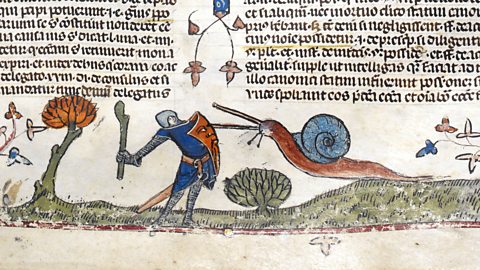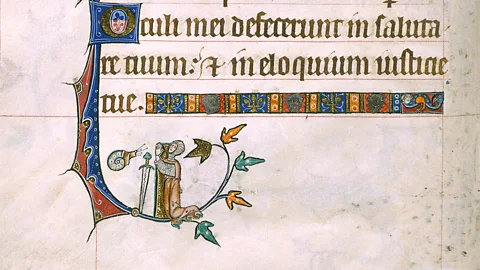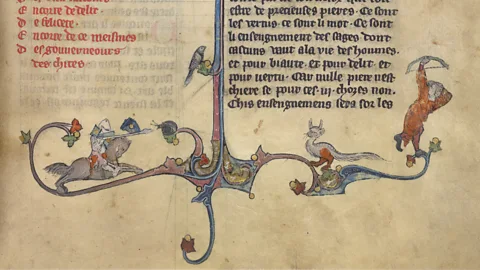The mystery of the medieval fighting snails
 The British Library
The British LibraryThe pages of medieval books are stalked by a ferocious monster: the fighting snail.
The knight pulls his arm back, poised to strike. He's dressed in the typical armour of the 14th Century, with a chainmail suit, belted tunic and bucket-style helmet. Standing within a small grassy clearing, he's holding up a shield which, inexplicably, has its own face. He also wields a club, which brushes the bottom of a swathe of religious text on the yellowed page of the medieval book he's drawn onto.
But even within the pages of antique tomes, knights must face mortal perils. This one's chivalric opponent is a particularly slippery beast – a foe often found slinking along in their margins and engaging noblemen in deadly combat. Sometimes the creatures appear to be hovering, attacking knights in mid-air. Occasionally there is more than one. This is the uniquely medieval phenomenon of the fighting snail – and to this day, why they were depicted remains utterly mysterious.
 The British Library
The British Library"This has created a good deal of puzzlement amongst art historians and book historians, wondering just what do they mean?" says Kenneth Clarke, a senior lecturer in medieval literature at the University of York in the UK.
"Marginalia" artworks are those found in the margins of books. In the Middle Ages, once the text of a manuscript had been finished, the most exclusive might receive a final flourish – intricate borders of curly foliage, fantastical creatures and other assorted drawings. Sometimes these were added immediately, and sometimes many decades later, but they were no casual undertaking – often painted with precious pigments like lapis lazuli or highlighted in gold.
"These were very, very, very expensive books, with very small numbers of readers," says Clarke.
You may also like:
The embellishments are found in a wide variety of religious works, including psalters (for songs), books of hours (for prayers), breviaries (for daily prayers), pontificals (for the rituals performed by bishops), and decretals (papal letters). They could be bizarre, playful, grotesque, and even rude – with bare bottoms, penises, medical conditions, and a surprisingly large number of bloodthirsty rabbits gracing the pages of otherwise sober devotional texts. Often, marginalia seem to have little connection to the text they're found next to.
But for a brief period in the late 13th Century, illuminators – those who decorated books – across Europe embraced a new obsession: fighting snails. For a comprehensive study of these warring gastropods, the art historian Lilian Randall counted 70 examples, in 29 different books – most of which were printed in the two decades between 1290 and 1310. The illustrations are found across Europe, but particularly in France, where there was a thriving manuscript-production industry at the time, says Clarke.
The specific scenarios that warring snails found themselves in varied, but broadly followed the same format of a snail-assailant standing off against a knight. Often, the molluscs have their antenna – technically their upper tentacles, or ommatophores – pointed aggressively forwards, as though they were swords. In one, a snail is shown fighting a nude woman. In a few they're not depicted as regular molluscs at all, but hybrids between snails and men – who are being ridden by rabbits, naturally.
Eventually, the warring snail meme even started to spill over into other places in the medieval world, such as cathedrals, where they were carved into facades or, in one case, hidden behind a kind of folding seat.
So why were they there?
 The British Library
The British Library"The snail-knight fight is an example of the world turned upside down, a broader phenomenon that produced a lot of different medieval images," says Marian Bleeke, a professor of medieval art at the University of Chicago. "The basic idea is the overturning of existing or expected hierarchies. It is supposed to be surprising and even funny – I think we get that implicitly today," she says.
However, whether these drawings had deeper symbolic meanings beyond this status-flipping remains extremely murky. "The knight ought to be brave and strong, able to defeat all enemies, but here he cowers in fear in front of a snail or is even defeated by one. Where we might disagree is where to go from there," she says.
Many interpretations have been put forward – including the idea that the snail fights represent the struggle between the upper and lower classes, or even the resurrection.
One leading idea is that the knights portrayed tackling snails represented cowardice – and their addition to religious texts may have been satirical. As Randall pointed out, many snail scenes involve a knight kneeling in prayer in front of his slimy attacker, or dropping his sword, with some showing a woman begging the gallant fighter not to engage such a deadly enemy.
Building on the theme of the gutless knight, Randall suggested that the snail motif may have been a political commentary – with the knights representing the Lombards, a Germanic people who ran the Lombard Kingdom in modern-day Italy until the late 8th Century. "[The Lombards were shown] as this group who were collecting taxes, but also involved in usury," says Clarke.
In medieval France – where most of the snail drawings were made – the Lombards were smeared in various ways, such as with suggestions they were unhygienic and cowardly. Randall noted that by the 12th Century, they had become synonymous with non-chivalrous behaviour in general. In one popular legend, a Lombard peasant encountered a heavily armoured snail, which the gods encourage him to fight – while his wife pleads with him not to be so reckless.
Clarke is sceptical of this particular idea, considering how common snail wars are in medieval books. Bleeke explains that today historians are less likely to expect marginal images to have such narrow meanings. "I just don’t think that’s how images work," she says. "I would want to look at how the snail was represented, what it looked like, and where it was located, in order to think about the meaning being made in a specific instance."
But whether Randall was right or not, Bleeke thinks they can teach us something important about how masculinity was viewed in the medieval world. "The brave, strong knight is an ideal or idealised version of masculinity, and the snail fight undermines that," she says. "To me these images show us that gender has never been as stable or secure as some people might want to think. It has always been a site of contestation."
--
If you liked this story, sign up for The Essential List newsletter – a handpicked selection of features, videos and can't-miss news delivered to your inbox every Friday.
